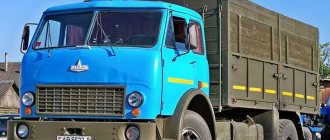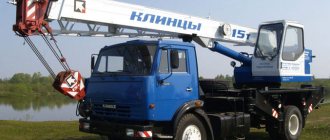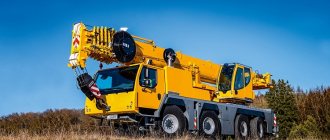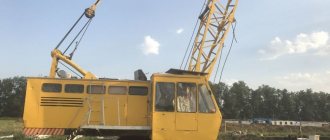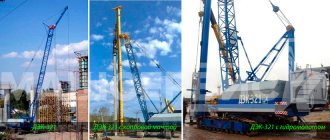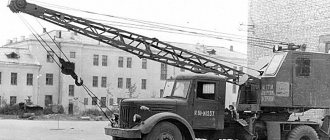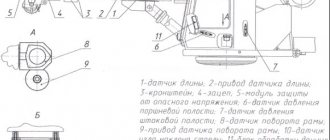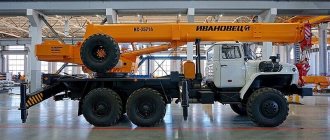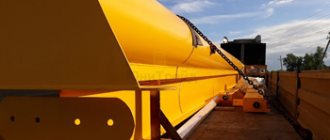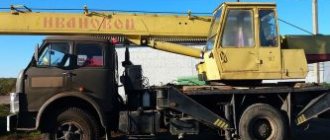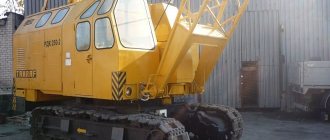Models
All machines have a unified design with separate electric motors for each mechanism. The hydraulic system is installed only on later versions. The crane installation is controlled by levers and pedals from a separate driver’s cabin located on the turntable. The lifting capacity of the machines is 7.5-14 tons.
The SMK-7 crane is an early modification of the machine, which used MAZ-200 trucks equipped with an in-line 2-stroke supercharged diesel engine as a base. On board the crane there was a special cargo winch designed to pull cargo into the work area.
The SMK-7 truck crane was later modernized by moving the installation onto a MAZ-5334 chassis equipped with a 4-stroke diesel engine with a power of 180 hp. The carrying capacity of all options is 7.5 tons.
SMK-10
Diesel-electric crane with a lifting capacity of 10 tons, built on the basis of a MAZ-5334 truck. A special feature of the design are screw outriggers, which are adjusted manually. The equipment was equipped with a 10 m long boom, which allowed the installation of 2 additional sections (3 m each). The design of the crane does not allow for movement with a load suspended on a hook. It is allowed to rotate the tower while lowering or raising the load or boom.
SMK-14
The SMK-14 truck crane, which has a lifting capacity of 14 tons, uses a MAZ-5337 truck as a base. The machine drives are equipped with asynchronous electric motors with an operating voltage of 380 V. The energy source is a generator mounted on a vehicle chassis. The rotor is driven by a power take-off gearbox mounted on the gearbox.
The generator has a distribution box designed for connecting external devices with a total power of no more than 30 kW. It is allowed to power consumers installed on the tap from an external 3-phase alternating current source. The SMK-14 truck crane connected according to this scheme can be used in rooms with poor ventilation.
SMK-101
The SMK-101 crane, designed to move cargo weighing up to 10 tons, is based on the MAZ-5334 commercial truck chassis. The crane installation is installed on a support circuit equipped with hydraulically driven outriggers. The hydraulic circuit includes a gear pump driven by a separate electric motor with a power of 3 kW.
Brief description of the technical characteristics of the machine:
- boom length - 8.6 m;
- extension insert size - 3 m;
- allowed number of inserts - 3;
- jib length - 1.5 m;
- load capacity at maximum boom and jib length - 2.5 t;
- superstructure rotation speed - 0.4-1.7 rpm;
- crane working area - 360°;
- generator power - 30 kW;
- engine power of the main and jib winch - 17.5 kW;
- rotation gear motor power - 4.1 kW;
- average fuel consumption during operation of the installation is 6.46 liters per hour.
Assemblies equipped with rollers or balls are used as a rotary shoulder strap. A stabilizer is installed in the machine’s suspension design, which eliminates distortions of the equipment during operation. On board the vehicle there is a separate winch for pulling loads, equipped with a 4.2 kW electric motor.
Crane SMK-101 with a lifting capacity of 10 tons
Construction machines and equipment, reference book
Crane SMK-101 with a lifting capacity of 10 tons
TO
category:
Self-propelled jib cranes
Crane SMK-101 with a lifting capacity of 10 tons
The SMK-101 crane is mounted on the MA3-5334 vehicle chassis. The drive of the crane is mechanical, the rest of the mechanisms are electric from its own generator.
Rice. 1. Truck crane SMK-101
Rice. 2. SMK-101 boom 8.6 m
Rice. 3. SMK-101 boom 11.6 m
The main boom, 8.6 m long, consists of two sections, extended with inserts up to 11.6; 14.6; 17.6 m. The 17.6 m long boom can be equipped with a 3.28 m long jib. The crane can have a load pulling mechanism. Working with a hook on a jib is provided at a reach of 7.5 m with a load capacity of 2.5 tons and a hook lifting height of 20 m. It is possible to move with a load weighing 2.5 tons on the hook of the main boom in the “backward boom” position at a reach of 3 m at a speed of 5 km/h with a hook lifting height of 5.5 m. Lowering depth is 3 m with a lifting capacity equal to half the rating. Crane weight—15 tons. Wheel track: front—1970 mm, rear—1860 mm. The turning radius of the crane 32 along the track of the outer front wheel is 12.5 m. The maximum load on the outrigger is 210 kN (21 t). The characteristics of the crane are shown in Fig. 4.35—4.40.
Fig 4. CMK-101 boom 17.6 m
Rice. 5. SMK-101 boom 14.6 m
Rice. 6. SMK-101 boom 8.6 m on the move
Rice. 7. SMK-101 boom 17.6—3.28 m
TO
category: – Self-propelled jib cranes
Electric truck crane SMK-14: Technical features
The diesel electric truck crane SMK-14 based on the MAZ-5337 (4x2) produced by the Ivanovo enterprise Ivenergomash is the only offer on the Russian market of special equipment. When powered from an external power source, this model is completely silent and can operate in enclosed spaces, and the presence of its own 30 kW generator allows not only to power the electric motors of the crane installation mechanisms, but also, if necessary, to service welding or other equipment with electric drives. The generator is capable of providing energy to a small populated area in an emergency, which is why the Russian Ministry of Emergency Situations respects the SMK-14 crane so much. In fact, this is a universal multifunctional equipment that is in demand not only by the Ministry of Emergency Situations, but also by energy workers, gas workers, oil workers, and farmers.
The SMK-14 truck crane has been produced without changes for several decades, which made it possible to test the reliability of all its components and assemblies. The rotating platform has a two-section boom with a screw mechanism for extending the section, a gearbox for the boom and cargo winches, a gearbox for the turning mechanism, as well as a hydraulic pump for activating the hydraulic cylinders of the outriggers. All mechanisms are driven by separate AC electric motors, receiving energy from a generator located on the lower support frame behind the chassis cab. The generator shaft is rotated by means of a belt drive by the diesel engine of the MAZ-5337 crane chassis using a PTO. If there is an external alternating current network with a voltage of 380V (50Hz), a cable consisting of 4 cores of the appropriate cross-section is connected to the generator terminals and after voltage is applied, crane operation is carried out.
It should be noted that the design of the boom equipment has a huge margin of safety and allows you to lift loads, if necessary, much greater than the maximum lifting capacity of 14 tons without causing emergency situations, which is very much appreciated by consumers of this equipment. In addition, the SMK-14 crane is significantly superior to hydraulic truck cranes in maintenance and reliability of components and mechanisms. The relatively small load capacity is compensated by the versatility of use of this machine. It is possible to jointly perform several crane operations simultaneously.
The cabin is equipped with a sprung seat, has sufficient glass, a hinged door has a built-in locking device, and is controlled by levers without requiring much effort. There is a set of necessary safety devices that make it possible to prevent possible emergency situations associated with overload or the approach of the boom too close to the wires of electrical lines.
Technical characteristics of the SMK-14 truck crane
Base chassis MAZ-5337 (4x2) Engine model/power, hp. YaMZ-6563.10 (Euro-3)/230 Load on front/rear axle, t 6.5/11.5 Max. lifting capacity/reach: 14 tons/3.5 m Load moment, t/m 49 Truck crane weight, kg 16100 Transport dimensions, mm 12450х2500х3980 Boom min./max., m 9.5-14.7 Hook lifting height max., m 14.5 Reach range, m 3.5-14 Support contour (along/across the crane axis), mm 3850x4700 Fuel consumption in operating mode, 9.5 l/h Landing 0.2 m/min
On the diagram of the SMK-14 load-height characteristics, the maximum lifting capacity is 14 tons for a boom with a length of 9.5 meters and a reach of 3.5 m. At a reach of 14 meters, the crane can lift loads weighing up to 1,700 kg.
Car MAZ-5334
Development based on the MAZ-5335 chassis - MAZ-5334 truck. A more modern truck from the late 70s of the last century. Description of appearance, changes compared to the previous version. Features of the three most popular modifications, their technical characteristics and areas of purpose. The entire MAZ model range.
Important Technical characteristics of the KrAZ-6510 dump truck and similar load-carrying analogues
Car history
In 1977, in step with global progress, production of the new MAZ-5334 truck began. The model was developed on the basis of the MAZ-5335. As always, the need for freight transportation increased in the rapidly growing republics of the Soviet Union. Along with this, the requirements for transporters also grew. In addition, due to the industrialization of cities, more modern vehicles were required to service them.
In order to solve this issue, this heavyweight was developed. A special feature of this MAZ is the ability to install various modular superstructures, structures and bodies for various purposes. Also, the technical characteristics have become more superior than those of previous versions of cars. Along with the carrying capacity, traction power has also increased, and there has also been a progression in maneuverability and speed characteristics.
Specifications
The basic chassis has the following main technical characteristics:
Cargo characteristics:
- weight when fully equipped - 7.025 tons;
- total weight - 15.225 tons;
- permissible weight on the front axle – 7 tons;
- permissible weight on the rear axle – 9 t;
- maximum load capacity – 8.2 tons.
- permissible trailer weight with cargo – 13 tons.
| YaMZ-236 | YaMZ-238 | ||
| Type | piston | Type | piston |
| Location | anterior, longitudinal | Location | anterior, longitudinal |
| Supply system | carburetor | Supply system | carburetor |
| Block material | cast iron | Block material | cast iron |
| Number of cylinders | V6 | Number of cylinders | V8 |
| Engine capacity | 11,150 cm³ | Engine capacity | 14,860 cm³ |
| Power | 180 hp | Power | 265 hp |
| Torque | 667 H*m | Torque | 882 H*m |
Description and technical characteristics of truck cranes
Truck cranes are one of the most popular types of construction equipment, widely used both in various types of construction and in loading operations.
The widespread use of these vehicles is due to their high mobility and ability to deliver cargo equipment to hard-to-reach areas.
The high maneuverability of truck cranes on the road allows them to participate in construction projects within the city without overloading the transport route.
The scope of use of this technology is extremely wide: from agriculture to industry, from emergency rescue operations to the construction of roads and bridges.
Software:
The system has a Web interface for operational monitoring of the condition of the building in real time and the level of liquid in the system, creating reports for any period of time and setting up the system. The adjustable parameters are the alarm settings for tilt and liquid level in the system, periods for polling sensors and updating readings on the screen, the period for archiving data and the storage medium for archiving information (streamer, hard drive, network drive).
Some nuances of the classification of truck cranes
The modern Russian market of automotive cranes is represented by both domestic and foreign models. All of them are distinguished by high performance and good technical characteristics.
A common feature for all cranes in this category is that the lifting machine is installed on a vehicle chassis, which determines its increased mobility.
Most often, Russian truck cranes are equipped with MAZ, KAMAZ, Ural, KrAZ, ZIL, etc. chassis as a chassis.
And here you will find not only the technical characteristics of the KamAZ-55111 dump truck, but also its advantages, thanks to which it remains popular, even after the model has been discontinued.
Due to their increased maneuverability, cranes with such a base are also called self-propelled.
Domestic truck cranes Galichanin, Yurginets, Klintsy, Ivanovets, whose technical characteristics meet all standards, have earned the trust of consumers.
Also popular are models from foreign manufacturers Libherr, Terex-Demag (Germany), Zoomilon, XCMG (China), Tadano, KATO (Japan), etc.
The chassis of the special equipment in question is equipped with an additional frame with outriggers, which guarantees good stability when lifting a load.
The design of these lifting machines also provides for a combination of basic working actions (lowering - lifting) with rotary rotation of the platform. They can be equipped with both flexible and rigid equipment suspension.
In the first case, the suspension mechanisms are fixed and tilted using ropes, in the second - thanks to screw mechanisms or hydraulic cylinders.
Truck cranes are classified according to the following criteria:
- load capacity;
- type of drive;
- possibility of operation with one or another type of replaceable equipment.
Self-propelled boom vehicles are divided into small class (load capacity from 4 to 8 tons), medium class (from 30 to 60 tons), high-load capacity class (from 40 to 250 tons).
The most widespread category are models of truck cranes with a lifting capacity of 20-25 tons , which have optimal technical characteristics.
Unlike special equipment with a larger carrying capacity, these vehicles consume much less fuel and have performance characteristics more suitable for city conditions.
Based on the type of drive, there is a division of truck cranes into machines with a single-engine and multi-motor individual drive.
The first category includes cars with a manual transmission, the operation of which is carried out using an internal combustion engine.
An example of a crane of this type is the legendary KS 22561 K-1, produced in the period from the 70s to the 90s of the last century on the ZIL basis.
The second group includes lifting machines in which each mechanism is driven by a separate engine. If the power plant includes an engine and a pumping station, the drive is characterized as hydraulic.
If the engine operates in conjunction with a generator complex, then the drive, accordingly, is electric (for crane models SMK-10, SMK-101).
The most popular models today are equipped with this type of drive. If equipped, the truck crane has a wide range of speeds and the ability to combine various crane functions.
Chassis
For stability in the transverse direction, some models use sliding trolleys. The main part is a fixed frame, which is supported by two crawler tracks with a drive. The tracks consist of numerous links and have a large area of support on the ground, which ensures low pressure, only about 0.1 MPa.
Instead of a mechanical drive, modern cranes today have a hydraulic drive. And such models are in good demand. They have two pumps. This allows you to simultaneously perform any operations, for example, lifting and turning, movement without a drop in pressure in the hydraulic system. Any operations on such cranes are performed accurately and smoothly. This is ensured by proportional valves in the hydraulic control. On cranes with hydraulics, the crane operator does not need to exert much effort to operate.
Some of the latest models of crawler cranes on the Russian market are equipped with a telescopic boom. Such an arrow provides a number of advantages. The required length is achieved not by installing additional inserts, but simply by extending the boom. It also becomes possible to transfer cargo in an additional plane.
Until recently, telescopic booms had almost 50% less lifting capacity than lattice booms. But today, ovoid profiles have begun to be used in telescopic booms, which has already increased their load capacity and continues to increase due to new technical solutions.
Moreover, the cost of cranes with lattice and telescopic booms is approximately the same, and sometimes the telescopic version is even cheaper.
In Europe, crawler cranes with telescopic booms are already very widespread.
Technical properties of truck cranes using a specific example
The description of the technical characteristics of self-propelled jib cranes includes the main parameters of the chassis (model) and engine (type and power), as well as the specifications of the crane installation.
In order for the consideration of the properties of a truck crane to be more detailed and visual, it is advisable to resort to a description of the characteristics of the KS-55722 machine based on KAMAZ-53228 from the Yurga Machine-Building Plant.
This crane belongs to the most popular category of lifting capacity - 25 tons. The lifting machine is equipped with a KAMAZ 740.31-240 (Euro-2) diesel engine with a power of 191 kW (260 hp). Wheel formula - 6x6.
The technical description of the crane installation itself includes the following list of properties:
- load capacity;
- maximum load moment;
- lifting height indicator;
- load lowering speed m/min;
- speed km/h;
- dimensions.
Lifting capacity refers to the ability of a truck crane to lift the maximum permissible weight of cargo for which the machine is designed.
The already mentioned specific figure of 25 tons also includes the mass of the hook and all removable mechanisms of the machine.
Featuring compact dimensions and good maneuverability, Yurginets easily gets to any construction site without creating traffic problems.
The truck crane is equipped with a special limitation mechanism that blocks operation when the permissible load limit is exceeded.
However, in order to correctly calculate the lifting capacity of any truck crane for a particular type of work, related factors should be taken into account.
These include the nature of the soil on which the truck crane will be based, the properties of the load itself (ease of grip, dimensions, fragile or damage-resistant material).
But the main properties that you need to pay attention to are the boom reach and lifting height. These parameters have a decisive effect on the lifting capacity of the truck crane.
The load moment is the fundamental criterion by which the technical capabilities of a truck crane are judged. For Yurginets it is 80 t/m, which indicates its excellent performance.
The load moment is determined as the product of the load capacity and the boom radius. In the vast majority of cases, it is the use of the indicators of lifting capacity, boom reach and load moment that allows a technically accurate assessment of a self-propelled crane.
The load-height properties of Yurginets allow this machine to be used in cramped conditions or in hard-to-reach places. An important role here is played by the presence of a telescopic boom, consisting of three sections.
The lifting height of the boom, as well as the load capacity, depends on the reach. It equals:
- for this model with a telescopic boom – 8.4-20.5 m;
- for the model with a jib (extension) - 27.4 m.
The landing speed of a truck crane is an indicator of the lowest speed of smooth lowering of the load during installation or laying. For Yurginets it is 0.2 m/min. The maximum load lifting speed is 18 m/min.
An important parameter is the transport speed of the crane, which for this model is 60 km/h. This indicator favorably distinguishes the machines from their counterparts with a higher carrying capacity, the speed of which in most cases does not exceed 20 km/h.
It is the operating speeds of the truck crane that affect its performance.
Also recognized as an important property is a coverage area of 290 degrees for handling loads. This characteristic is very important when determining whether the technical capabilities of the crane are suitable for different types of work.
The overall dimensions of the KS-55722 lifting machine in the transport position are presented as follows: length – 10,150 mm, width – 2,500 mm, height – 3,850 mm.
The total weight of the Yurginets truck crane, calculated with a full fuel tank, with all associated removable and transport mechanisms, is 20,750 kg.
The technical characteristics of this truck crane can be supplemented with the following parameters:
- maximum load on the axle when moving: on the front - 5.53 t/s, on the rear - 15.22 t/s.
- The highest departure angle of 18°, overcome by the crane at a constant speed, allows it to function even in off-road conditions.
The temperature range at which the Yurginets truck crane can be operated is from -40°C to +45°C. This allows the special vehicle to be used in various climatic conditions without causing damage to the main mechanisms.
Germany
TAKRAF
Indexation of truck-mounted, crawler, pneumatic wheel cranes of the TAKRAF brand:
Index ADK (German: Auto Dreh Krane, automobile rotary crane). Used for automotive cranes. After the letter designation, the carrying capacity in tons is indicated:
- ADK-3 is a truck-mounted crane with a lifting capacity of 3 tons.
If the crane is equipped with a telescopic boom, some models were indicated with the letter “T”. After indicating the load capacity, the serial number of the modification is given.
EDK (German: Eisenban Dreh Krane, railway slewing crane) Used for railway cranes. Load capacity:
- EDK-300 (60 t);
- EDK-500 (80 t);
- EDK-1000 (125 t);
- EDK-2000 (250 t).
Index MDK (German: Mobil Dreh Krane, mobile rotary crane). Used for pneumatic wheel cranes. After the letters “MDK” there are two numbers indicating the load capacity in tons:
- MDK-50 - mobile slewing crane, lifting capacity 50 tons, basic model.
If there is a difference from the base model, after indicating the load capacity, the serial number of the modification is given:
- MDK-504 is a mobile slewing crane with a lifting capacity of 50 tons, fourth modification.
Index RDK (Raupen Dreh Krane - crawler slewing crane). Used for crawler cranes. After the letters “RDK” there are two or three numbers indicating its load capacity.
- RDK 25 is a crawler slewing crane with a lifting capacity of 25 tons, the basic model.
- RDK 250 is a crawler slewing crane with a lifting capacity of 25 tons, the basic model.
- RDK 280 is a crawler slewing crane with a lifting capacity of 28 tons, the basic model.
Important Cultivators for hilling potatoes and cultivating land
If it differs from the base model, the serial number of the modification is indicated with a hyphen. Example:
- RDK 250-3 is a crawler slewing crane, with a lifting capacity of 25 tons, of the third modification.
- RDK 630-1 is a crawler slewing crane, with a lifting capacity of 63 tons, the first modification.
When manufacturing a faucet in a special climatic design, after the modification number, a special designation characterizing it is added; for example, if the crane is made in the “northern” design, the Polar designation is added:
- RDK 250-4 Polar - crawler slewing crane, lifting capacity 25 tons, northern version.
FAUN
Truck cranes on special chassis from FAUN. This type of crane is intended for installation, as well as loading and unloading operations at dispersed bridge construction sites in temperate climates. Indexation is shown in the following example:
Crane HK-100.05 - crane with a lifting capacity of 100 tons, 5th model.
